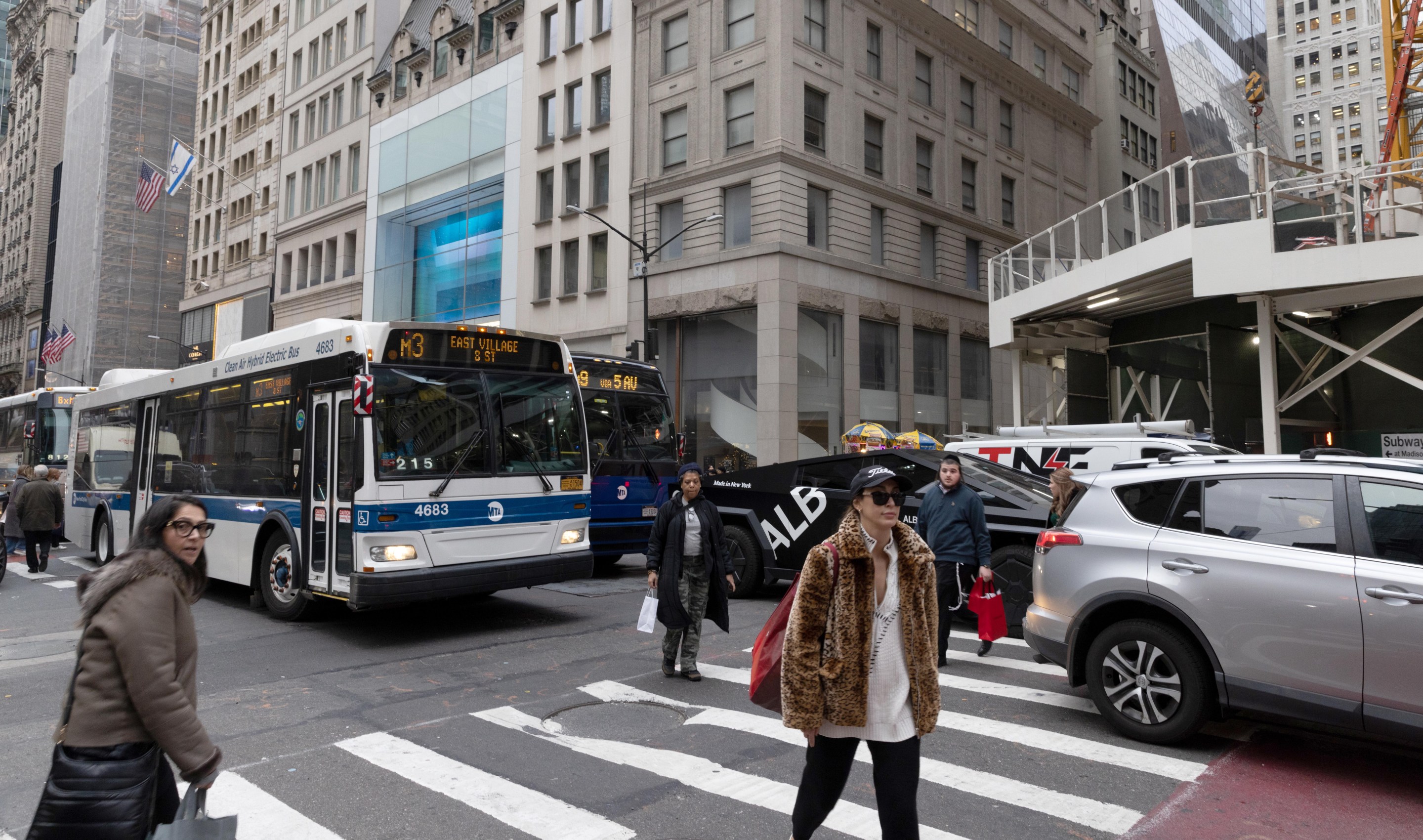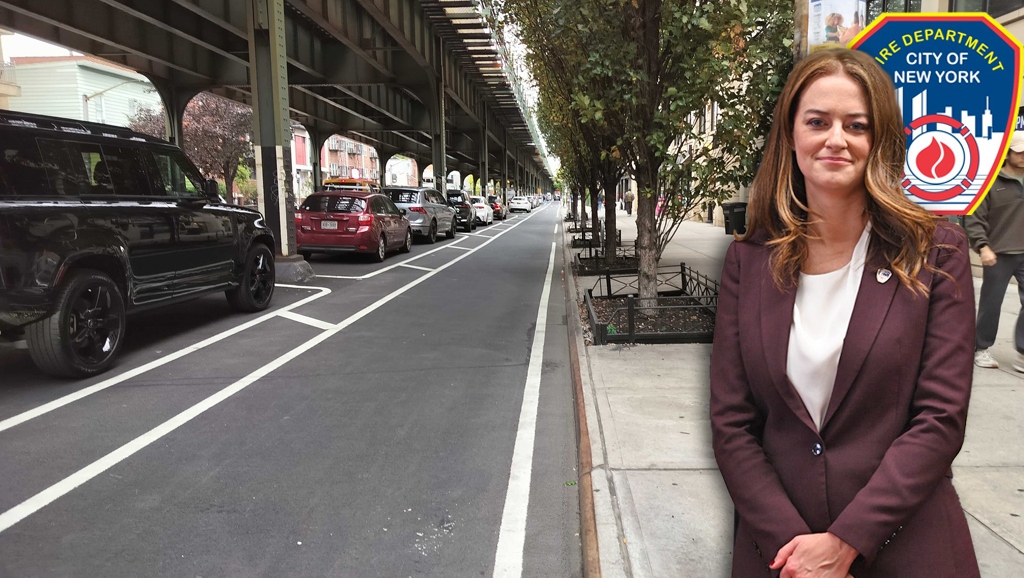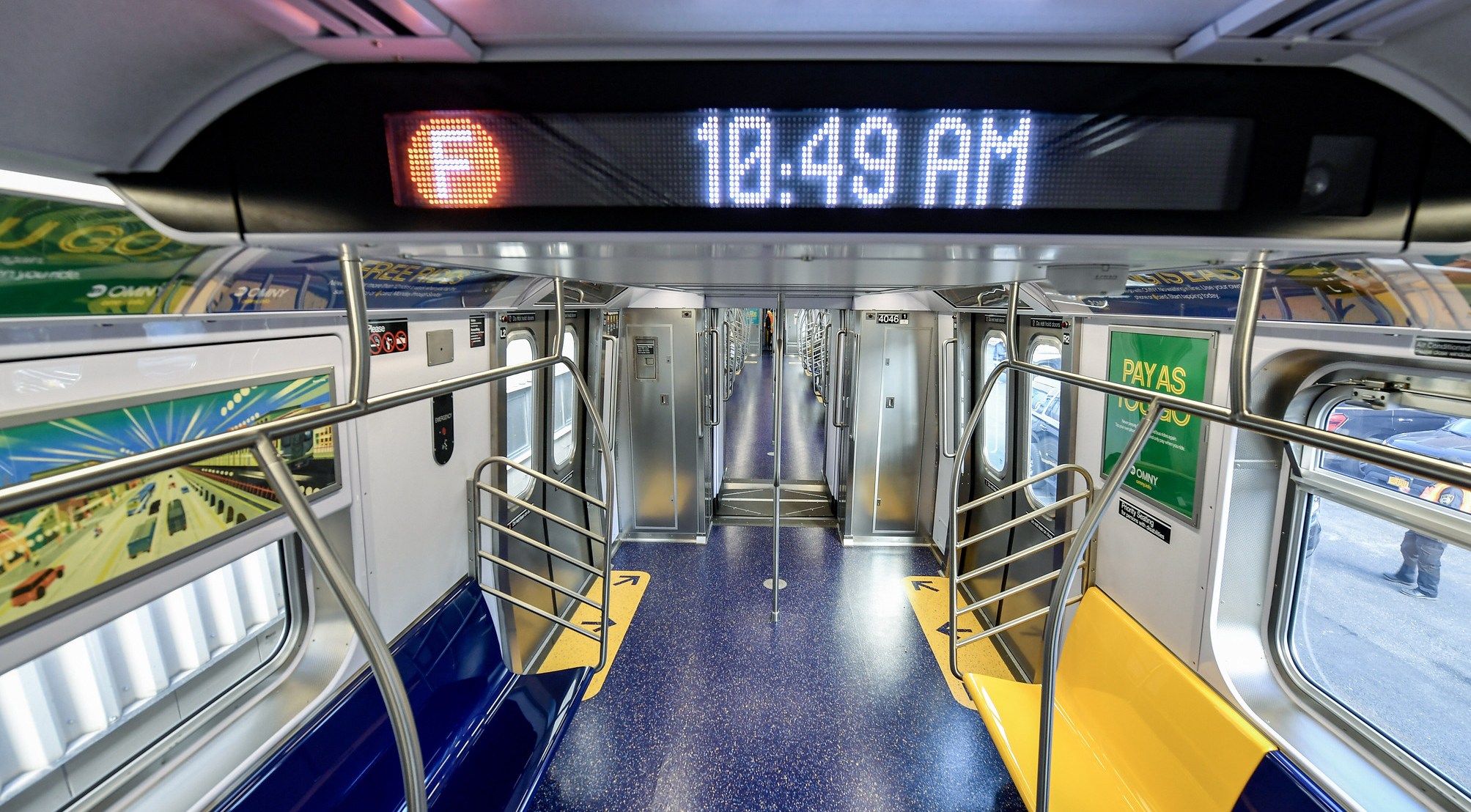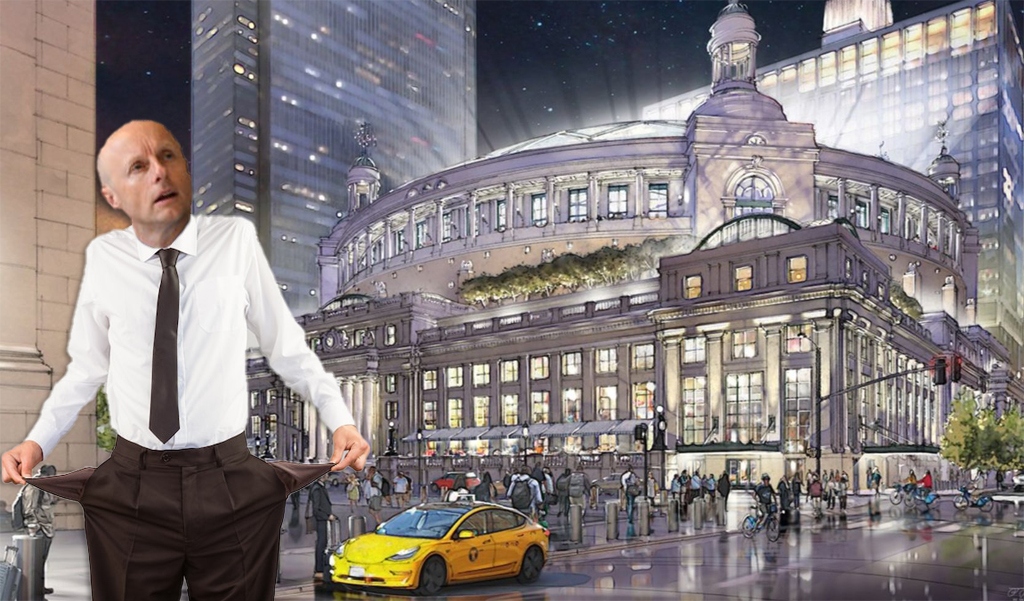Congestion pricing finally launched on Sunday, but key street-level improvements that Mayor Adams promised in order to take advantage of the drop in car traffic haven't happened — including, crucially, the long-overdue bicycle and pedestrian path expansion on the Queensboro Bridge.
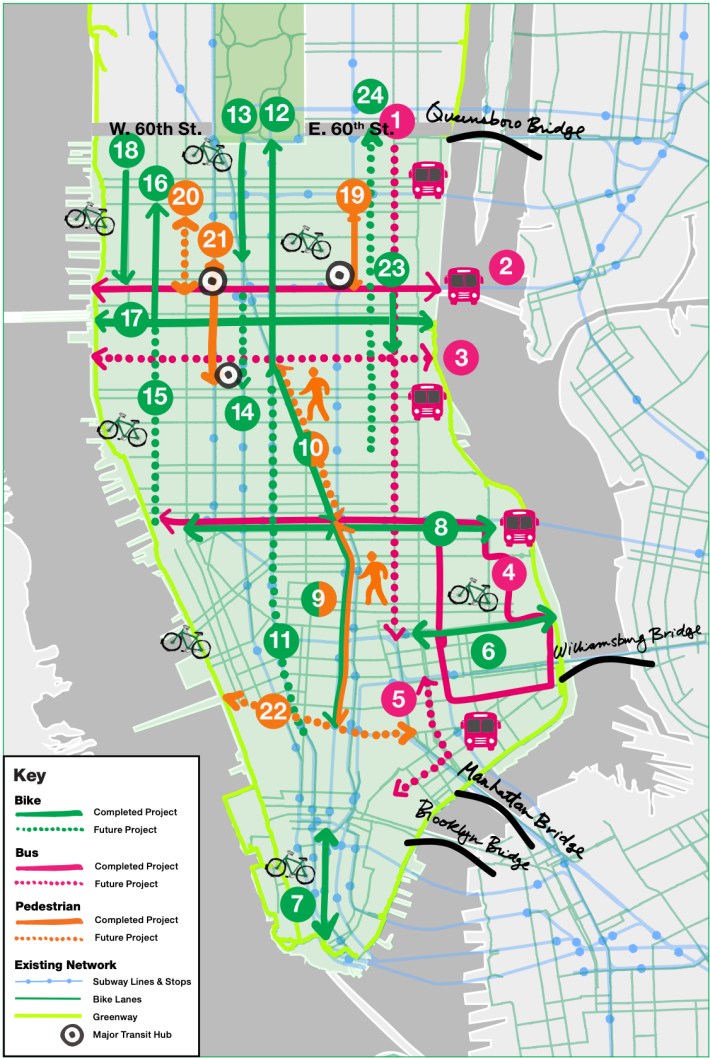
The revamp of the bridge's south outer roadway to free up space for cyclists and pedestrians currently crammed — in both directions — on the narrow north outer roadway is one of several projects Adams's Department of Transportation included in its "Connecting to the Core" initiatives released last year ahead of the toll's initial planned June 2024 launch.
MTA official forecast the toll will cut car traffic in the congestion relief zone below 60th Street by about 13 percent. Fewer New Yorkers in cars likely means more demand for bike lanes and bus lanes.
But as with the Queensboro Bridge upgrade, many crucial "Connecting the Core" projects remain on the back burner or face delays — as has often been the case since Adams took office. Hizzoner has shown little urgency to reimagine the Big Apple's streets to make room for people on bikes, buses and foot.
"In the period of time during which drivers are rethinking their commutes, there’s really an abundant opening to reclaim public space for its highest and best use, which is the movement of people and goods, not the status and convenience of a few," explained Danny Pearlstein, director of Policy and Communications at Riders Alliance, one of the key groups behind the push for congestion pricing.
It's not too late for the Adams administration to take advantage of the historic opportunity provided by congestion pricing. Here's a rundown of what they need to accomplish:
Bridges
The main way many New York City commuters travel into the congestion relief zone is via the East River bridges, but DOT has repeatedly pushed back its plan to make that any easier on the Queensborough Bridge — the only span directly connecting Manhattan to the city's second-most populous borough.
Right now, pedestrians and cyclists must squeeze into the bridge's north outer roadway's shared multi-use path. DOT's plan since at least 2017 has been to provide pedestrians dedicated space on the bridge's south outer roadway. But that's taken years to materialize. DOT blew past its planned summer opening; the agency most recently said the new path would open sometime this winter.
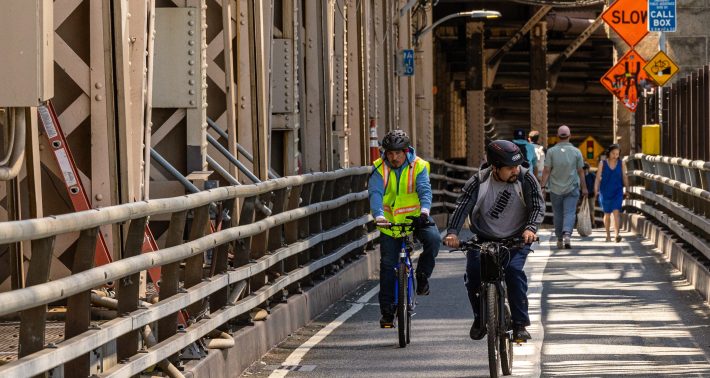
The agency insists it needs to keep as many lanes as possible open to cars amid a lengthy replacement of the bridge's upper deck, but the drop in car traffic from congestion pricing ought to open up space going forward, according to Jon Orcutt, who served as DOT's Director of Policy during the administrations of Michael Bloomberg and Bill de Blasio.
"The toll increased from $0 to $9 on the Queensboro Bridge, it’s really time to make more room for a full bike lane there," said Orcutt, who is now advocacy director at Bike New York.
But why stop there? The city should also add a second bike lane to the Brooklyn Bridge, where de Blasio opened a cycling path in the roadbed in 2021 that's already often at capacity, said Orcutt.
"What’s the rationale for having two inbound lanes and three outbound lanes on a bridge that has no trucks and no buses," the advocate said.
Further uptown, officials should revive a 2018 plan to improve connections over the Harlem River bridges to the Bronx, he said.
DOT belatedly added a two-way bike lane and a bus lane to the Washington Bridge over the summer, and the Henry Hudson Bridge — managed by the Metropolitan Transportation Authority — is supposed to get a new path this year. But the remaining overpasses have no active plans, even after Adams told Streetsblog in 2023 that he wanted to "open up all these bridges."
Connections to the bridges also need improvements, Orcutt said. He cited the need for a safe link from the Kościuszko Bridge to the recently opened Queens Boulevard bike lane extension, as well as the traffic mess around Downtown Brooklyn's Jay Street that undermines the corridor's bike lanes and busway.
Speeding up the bus
Speaking of buses, congestion pricing will hopefully speed up the surface transit as it speeds up traffic in general. Adams could take those service improvement even further if he finally decided to improve commutes for city bus riders who currently experience the slowest travel bus speeds in the country.
One of the most obvious upgrades would be to copy and paste the successful busway on 14th Street on other crosstown corridors in the zone.
Launched in 2019, the 14th Street busway banned through-traffic of personal vehicles and boosted bus speeds by 24 percent, and ridership by up to 30 percent, according to DOT.
Next up could be 34th Street, which has been in discussion for years and was included in DOT's list of upcoming projects in the zone. Adams could also return the plans for Midtown's Fifth Avenue — the busiest bus corridor citywide — to a true busway proposed by de Blasio in 2020, after the former and current mayors watered it down several times — most recently threatening to worsen bus service along that street.
Busy outer-borough roads also carry many bus riders to Manhattan or trains lines that go to Manhattan. They also desperately need the upgrades, including Flatbush Avenue in Brooklyn, which connects the borough's outer reaches to the subways in Downtown Brooklyn going to Manhattan.
"Flatbush brings a lot of people into the central business district," said Pearlstein.
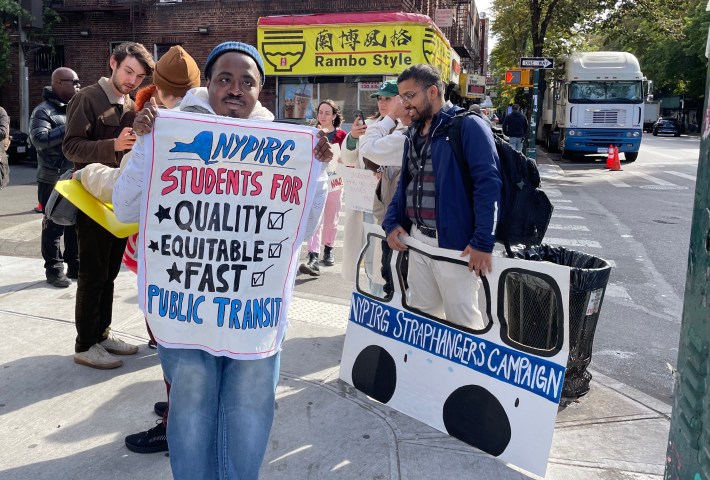
Meanwhile in the Bronx, Fordham Road still needs a proper bus priority upgrade after Mayor Adams bowed to business interests and scaled back the city's plans. The thoroughfare carries the busiest buses in the Bronx, and connects to upper Manhattan via the University Heights Bridge.
Another promise of DOT's "Core" plan was bus upgrades on a short section of Tremont Avenue, which the agency plans to install this spring, and would also offer a better east-west connection for Bronxites.
The project could also help relieve some of the worries about increased congestion outside the zone, such as in the South Bronx, said Pearlstein.
"If we’re concerned about additional traffic on the Cross-Bronx Expressway, we should free up that roadway for trucks and buses," he said of Fordham Road.
Bike lanes
DOT rolled out some important bike lanes in recent years that it also included in the report, such as the Brooklyn Bridge path and McGuinness Boulevard, but there are still plenty of to-dos in and around the congestion zone.
The extra-wide bike lane on Third Avenue has become a vital north-bound path for cyclists, but currently ends at the beginning of the congestion zone at 59th Street. "Connecting the Core" indicated that DOT was looking to extend it south to 23rd Street, which would make sense, given the reduced need for the East Side road's seven lanes for the movement and storage of cars. That hasn't happened yet.
There are also potential new crosstown bike connections, such as 72nd Street, which the city's "Core" plan listed, and other ideas, like the Central Park Conservancy-backed idea to put a protected bike lane in the park's 86th Street transverse, which could entice more people to switch to bikes uptown to get from one side of the island to another.
A bike lane hardening on Delancey Street would also benefit commuters riding to and from the busy Williamsburg Bridge, where bike ridership from populous north Brooklyn into the central business district has been growing. But the ribbon-cutting for that federally funded project won't be until 2029 at the earliest.
Much of Brooklyn could have a much easier and safer bike ride to Manhattan if Adams closed the gap connecting the protected bike lanes along Fourth Avenue to Ashland Place, which continues on to the East River bridges.
City Hall notoriously stopped one block short in Fort Greene to appease a developer whose garage was facing the street, but now that Adams's senior adviser and bike-lane-saboteur-in-chief Ingrid Lewis-Martin has resigned amid a corruption investigation, DOT should fill in that gap.
"The Adams administration screwed that by leaving a block out. But they could fix that this year with the changes at City Hall, and they should fix that," Orcutt said.
Mass pedestrianization
Swaths of Downtown Manhattan are beyond ready for pedestrianization, and with fewer cars around, there are even fewer excuses to transform the public realm by repurposing the scarce street scape away from cars and for people, advocates said.
A prime example are the narrow streets of the Financial District, where people literally spill off the sidewalk into the roadway, said Sara Lind, the co-executive Director of the advocacy organization Open Plans (which shares a parent organization with Streetsblog).
"This is a dream scenario, to be gifted more space in New York City. But we have to make the most of it and show New Yorkers that congestion pricing can reshape their city for the better," Lind said.
The city should also redo car-choked corridors like Canal and Houston streets.
"Let’s give them the Union Square treatment — lots of pedestrian space with supercharged bike and bus lanes," Lind said.
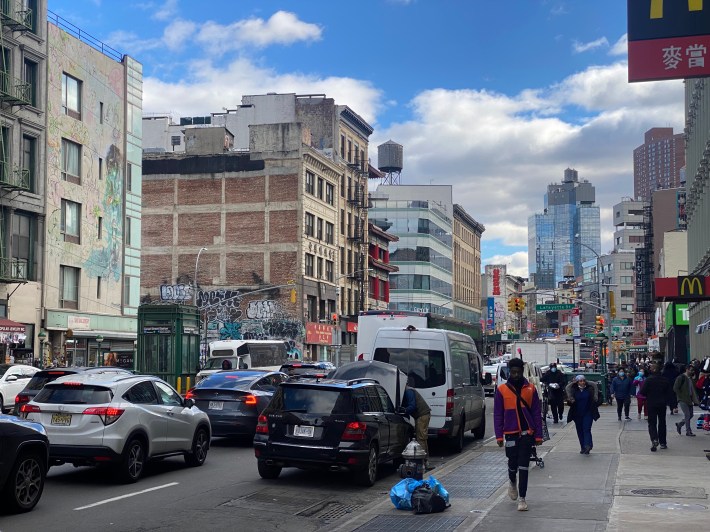
DOT announced a study of Canal Street two years ago, but has yet to release the results or follow-up plans from that review.
Officials could also pilot low traffic neighborhoods, by banning through-traffic on blocks, a design that's been around since the days of horse-drawn carriages in ancient Rome.
"It's the perfect time to try new-to-New-York ideas, especially ones that are already succeeding elsewhere," Lind said.
